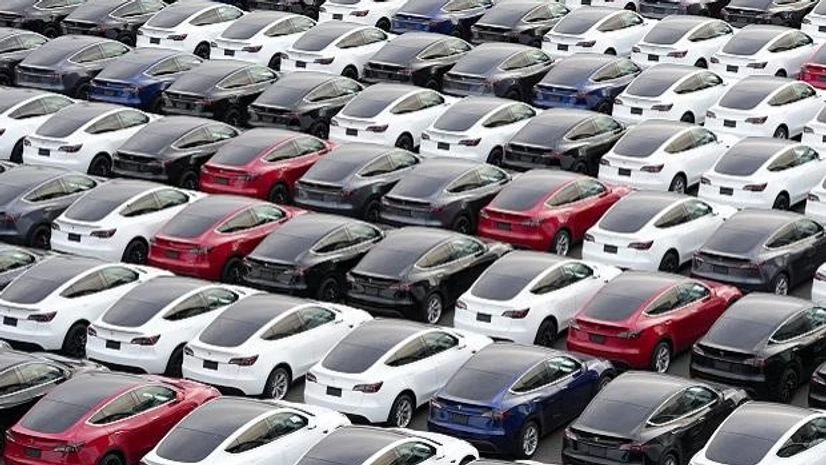By-Anjani Trivedi
Chinese automakers are repeating past follies. That may be a good thing.
Chinese automakers are repeating past follies. That may be a good thing.
As electric vehicles eat into their traditional peers’ market share, manufacturers are aggressively cutting car prices to lure buyers. That looks like the beginning of yet another bust-boost-boom cycle: a period of flailing demand, followed by incentives to stimulate buying, and then, hopefully, sales surge.
The boost part, though, is looking a bit tenuous for both established and EV firms. While the central government hasn’t stepped in with overarching policy-backed incentives for the wider auto market as it did in the past, local authorities are rolling out subsidies for buyers and manufacturers. Car companies are throwing in sweeteners while incumbents are trying to clear stocks of internal-combustion-engine vehicles that consumers will soon shun. EV makers are attempting to keep up with falling prices and rising competition.
An imminent emissions regulation that kicks in this July is fueling the growing anxiety. Earlier this month, SAIC Volkswagen Automotive Co. offered over $500 million in cash inducements to buy vehicles. It followed over 40 brands that have done the same. The frenzy forced the industry association last week to urge companies to tamp down on the “price-cut hype.” A few days earlier, state media called the provincial level moves improper.
Since Tesla Inc. lowered its prices in China late last year, deepening the electric transition in the world’s largest market, traditional carmakers and their EV peers have been scrambling for solutions to keep up. So far, they’ve only emerged with haphazard measures, but a more surgical approach may be the only option as the fittest emerge on top.
Also Read
Tesla and BYD Co. aren’t making it any easier, as they churn out in-demand electrics en masse at ever-lower prices. Brands like General Motors Co. and Hyundai Motor Co. once significant players in the overall market, accounting for 18% and 10%, are now waning. The world’s largest manufacturers, Volkswagen AG and Toyota Motor Corp., have fallen behind, too.
But old tricks aren’t working the way they did. Overall sales fell 15% in the first two months of the year. These band-aid measures to fix structural issues in the market clearly aren’t sustainable and can’t last for too long. Cutting prices and doling out incentives will raise costs and eat into already-thinning margins. But perhaps the painful fallout is what’s needed.
The breakdown of the years-long boom-bust cycle has a silver lining: A thorough, clean up of China’s vast car market. Auto manufacturers — traditional and electric — that can’t keep up, including small firms and random brands, will likely be wiped out or consolidated, clearing the way for better vehicles. The ones big enough to hold on will have to raise their game. Domestic champion Geely Automobile Holdings Ltd., for instance, has been waffling under the transition. It is now investing in hybrids and greener, more efficient internal combustion engines.
The price wars and current chaos should force a deeper reckoning in China’s burgeoning EV market, which is now veering toward overcapacity. Factory utilization rates are around 60% and could go lower as more manufacturing plants come online. Beijing has already warned about risks of a glut. Regulators could help streamline the industry’s growth by setting stringent standards for vehicles as they did for batteries. Manufacturers will have to do their part, too, finding a balance between regulation, scale and technology.
For now, some Chinese automakers have been able to take advantage of strong production at home. As the rest of the world attempts to transition to EVs and struggles to manufacture at scale, China has been able to fill the vacuum. So many EVs are being churned out that the country has claimed the title of the world’s second-largest new vehicle exporter. Firms are gaining share in Chile, Saudi Arabia and Southeast Asia. That may serve companies well in the short term, but getting used to the thrill of new and growing markets risks losing sight of a problem China knows all too well: the pitfalls of mass production. Making lots of cars is one thing, but without constant and consistent technological upgrades and investment, the ride won’t last.
If Beijing can resist the urge to wade in when failures rise and instead, watch the cycle play out, it may end up with an evolved version of the wider auto market. A range of solid, high-tech and affordable EV options would be an ideal outcome from the ongoing turmoil.
Disclaimer: This is a Bloomberg Opinion piece, and these are the personal opinions of the writer. They do not reflect the views of www.business-standard.com or the Business Standard newspaper

)
